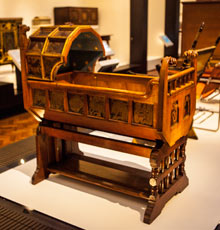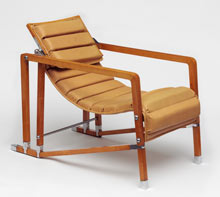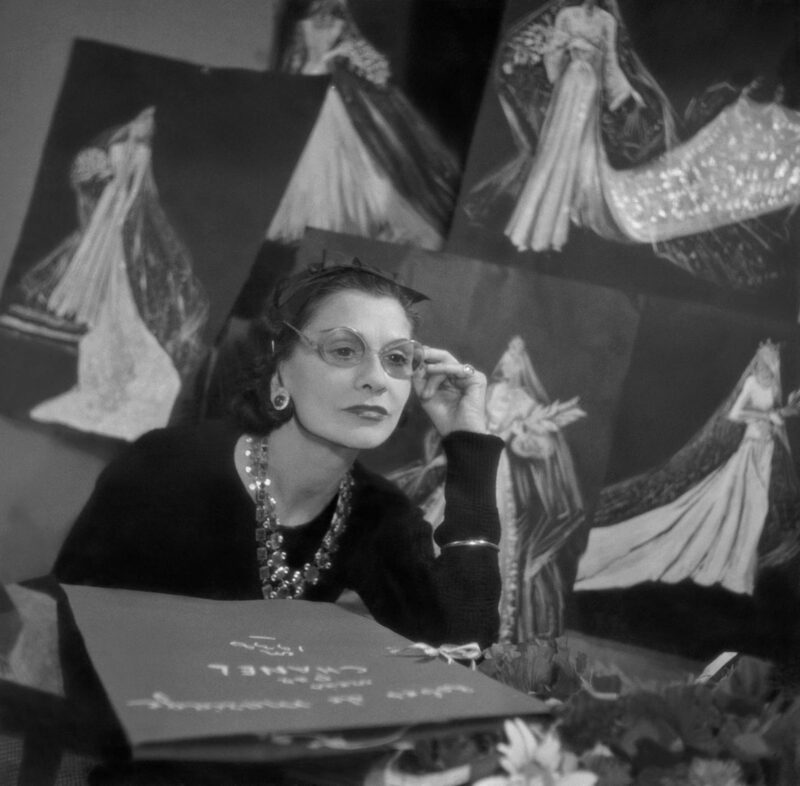
Model 4801, Chair, Joe Cesare Colombo (Designer), Kartell (Manufacturer), 1967-70. Museum no. CIRC. 214-1970
“Some people will find it quite disturbing,” says Nick Humphrey, curator of the new furniture gallery at the Victoria and Albert museum, a space the museum has lacked in its entire 155-year history. We are walking down a long, narrow gallery at the top of the rambling gothic pile in South Kensington, surrounded on all sides by opulent carving, intricate marquetry and lustrous lacquerwork. It is a heady cocktail of materials and techniques, which might provoke some gaudy nightmares. But it’s not this that Humphrey thinks is cause for alarm.
We stop at a handsome bureau cabinet from the 1730s, believed to have belonged to the satirist Jonathan Swift. The cabinet has an imposing facade, fluted Ionic pilasters rising from a walnut plinth to support a crisp moulded cornice: a classical temple turned into a cupboard. “Pieces like this were always set against the wall,” says Humphrey. “You’re only supposed to see it from the front.” He walks me around the back to reveal rough panelling, not too different from the flimsy boarding that lurks behind every Ikea wardrobe. Next to it stands the writhing opulence of a rococo revival sofa, ripe berries carved into a frothing rosewood filigree. Only from behind can you tell that it is cut from a kind of plywood, the structural joints and laminated layers exposed for all to see. “We want to show people what goes on backstage,” Humphrey says. “The purpose here is to explain how these things are made.”
This is a radical switch for a museum that has often acted as a kind of mausoleum for the decorative arts, full of objects stuck behind glass cases along dimly lit corridors. But the last 10 years have seen the cobwebs blown away by the museum’s ambitious refurbishment programme, which has seen new spaces created for jewellery, ceramics and fashion, as well as the opening of the expansive medieval and renaissance galleries.
But the furniture gallery is the most interesting yet, setting a new bar for how the V&A’s collection can be displayed, with a focus on telling the stories behind the objects. Until now, furniture has appeared here only in the context of period displays – as props for the theatre of domestic life, tools through which to examine the social mores of the time. Now there is a shift in focus towards the importance of the crafted object: it is all about making, and the skills of the makers.
The gallery’s central spine places around 25 pieces in chronological order from 1400 to today; on either side, most of the 200 other objects are organised by technique, in a series of 16 themed displays. These draw parallels between unlikely bedfellows. In the carpentry display, a chair leg torn from an ancient Egyptian throne stands next to an 18th-century commode. The open wound of the leg’s stump reveals how it was originally connected to its host with a mortise and tenon joint, of the same kind used three millennia later in French cabinetry. The commode has been replicated to the side with an exploded model showing its intricate use of sliding dovetail, frame and panel, exposing the complex skeleton beneath the mirror-polished surface.
In the same display is Humphrey’s current favourite (“it changes every month,” he says): a simple English “joint stool” from 1600, of robust turned legs connected by 16 mortise and tenon joints. “It is a 400-year-old workhorse: a stool, a table, something to stand on to reach a shelf – and often used to rest coffins on,” he says. “It is a simple witness to life and death.”

These stories are elaborated on touch-screen panels, removing the clutter of explanatory labels. The complete lack of captions is potentially frustrating for fleeting visits, but it does force you to look at the pieces objectively, before discovering their provenance. “Our aim was to have the least amount of stuff between the object and the viewer,” says architect Graeme Williamson, of Glasgow practice Nord, which worked to whittle down the usual layers of caption and glazing, to achieve the gallery’s beautifully clear design. “We wanted to bring the furniture as close to the visitor as possible.”They have also raised the objects higher than usual, closer to the level of the workbench, to give a craftsman’s eye view. The simple monochrome palette, of dark, ebonised oak and bright white slabs of marble-like acrylic, also recedes into the background, putting the wealth of materials centre stage.
This crisp, minimal design works particularly well for the lacquer display, where a stunning 16th-century Japanese coffer, densely inlaid with mother of pearl, is contrasted with an art deco folding screen by Eileen Gray from the 1920s. Gray studied under the Japanese master Seizo Sugawara in Paris, and translated the ancient technique into this bold geometric piece, which remained in her home until her death. Alongside these, and many other pieces of “Japanning” from across Europe, is a panel produced by a Japanese Living National Treasure (a title bestowed on an elite of elderly craftsmen) for the V&A, which shows the painstaking process of building up the inky black surface with 30 preliminary layers, before the subtleties of decoration can begin.
Balancing this focus on technique, the gallery also tells the stories of key personalities from different periods: Orkney joiner David Kirkness, whose vernacular straw furniture resonated with the arts and crafts movement, produced more than 14,000 chairs for admirers including King Edward VII; and George Brookshaw, the 18th-century “Japanner”, who guarded his secrets so closely that he only painted behind locked doors. “We didn’t just want it to be about the best, or the most famous names,” says Humphrey, “but about those that tell a broader story of how furniture is made, the people who pioneered specific techniques and different ways of doing things.”
It is a philosophy that runs through the gallery, and it is what makes the curatorial choice so refreshing. There are new finds for even the most hardened furniture fanatic, from Norman Shaw’s gothic cradle to Eugène Berman’s surrealist, trompe l’oeil wardrobe, to an ingenious contraption that converts from writing desk to card table. It is a brilliant addition to the museum, and sets a new standard for bringing the collection to life.
Architects on their favourite designers

Amanda Levete on Eileen Gray: This chair is very personal for me, because Eileen Gray was a designer first, then an architect; for me it’s the reverse. It’s like architecture in miniature: every piece is doing exactly what it should. The sycamore frame supports this low-slung piece of leather, and the chrome joints hold it all together.
She designed it for the house she made for her lover, Jean Badovici, which was all about its aspect overlooking the Mediterranean. Inside, it was a clean, simple space: straight lines and lots of light. Every piece of furniture was designed by her: it was an opportunity for her to create a total environment, which is what we all aspire to do.
The chair makes you think of a languid afternoon looking out at sea, reflecting the house, which was like a beached liner on the rocks. And its name, the Transat Chair: it’s a deck chair you’d find on a transatlantic liner. So it reminds me of a kind of relaxation, a lying back and observing. It’s very sensual.
David Adjaye on Frank Lloyd Wright: I completely identify with Frank Lloyd Wright’s desire to make his furniture connect with his spaces, because then you’ve created the complete package. If your architecture moves an agenda on, it dislocates itself from the products of that time – and you don’t want your architecture to be left alone with furniture from another period.
Frank Lloyd Wright really dreamed about what the future could be. His 1904 Larkin chair could come from the set of Metropolis. It celebrates construction: its screws are exposed, nothing is finished or smooth.
Imagine 1904. Think of the fashion, the clothing, and then consider this extraordinary robot. It’s your first encounter with a robot and it’s your chair: it serves you. Somebody who works in this environment would have an extraordinary feeling of being transported into a unique, magical world.
Listen to more architects on their favourite designers
• This article was amended on 28 November 2012. The original referred to discovering the exhibits’ providence rather than provenance, and has been corrected.
guardian.co.uk © Guardian News & Media Limited 2010
Published via the Guardian News Feed plugin for WordPress.









